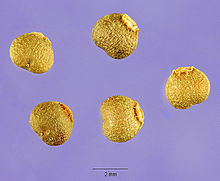Fumaria officinalis
Fumaria officinalis, commonly called moth or blood of Christ —among many other names—, is a species of annual herbaceous plant of the genus Fumaria in the family Papaveraceae, native to Europe.
Description
It is a glabrous herb, with an erect and well-branched stem, quite diffuse and reaching 50 cm in height. It presents pinnaticompound, alternate leaves, with the last leaflets almost linear. In early spring it forms inflorescences in terminal racemes of between 10 and 25 zygomorphic flowers, each up to 9 mm long. The flowers have the calyx formed by two small sepals, whitish in color, ovate, with a toothed edge, narrower than the corolla, pink in color, which is composed of four petals united at the apex but free, of which the superior is prolonged in a spur. The androecium is diadelphous, that is to say, with 6 stamens fused by their filaments into two groups, each of which seems to be divided into 3 anthers. The gynoecium shows two carpels, with the superior ovary. The fruit is a small striated/rough globose achene, more or less truncated.
- Cytology
- Basic number of chromosomes: x=16
Distribution and habitat
Native to Europe; Linnaeus, in his original diagnosis, indicates: « Habitat in Europae agris, cultis ». Cosmopolitan; introduced to North America.
It grows on cultivated land or dry soil plains.
Systematics
Fumaria officinalis was described by Carlos Linnaeus and published in Species Plantarum 2: 700. 1753.
Etymology
See: Fumaria officinalis: Latin epithet meaning "used as a medicinal plant".
Synonymy
The following synonyms are recognized:
- Fumaria angustifolia Gilib., Nom. Inval.
- Fumaria cilicica Hausskn.
- Fumaria cirrhata Rohde ex DC.
- Fumaria diffusa Arn. ex Parl.
- Fumaria disjuncta Jord. ex Nyman
- Fumaria gaspariniiBab.
- Fumaria major V.Ten.
- Average number Loisel.
- Fumaria muraliformis Clavaud
- Fumaria muralis Gren., Nom. ileg.
- Fumaria officinalis var. elegans Pugsley
- Fumaria officinarum Neck.
- Fumaria petteri V.Ten., Nom. ileg.
- Fumaria pulchella Salisb.
Relationship with man
Uses
The light infusion is used as a liver regulator, diuretic and laxative, and topically, for scalp conditions. Overdose should be avoided, as the alkaloids it contains are cardiotoxic in high doses.
In its chemical composition are, among others:
- about 20 alkaloids (0.15-0.3 p.p.m.),
- protoberines,
- indobenzodiazepines,
- protopin (a compound of opium, which acts in a similar manner to papaverin): about 0.13%, combined with the fumaric acid in the form of protopin Smokingate,
- cryptonine,
- flavonoids,
- phenolic acid,
- Fumaric acid.
Common names
- Dove Buche, ferribusterri, terribusterri, virgin nightgown, Child Jesus nightgowns, queen cape, rabbits, rabbits, dove neck, Smoking, Smoking office, fumoterra, fumusterra, gypsis, gypsies, gypsies, rabbit herb, rabbit herb, minutisa, pig, common dove, office dove, pigmina, pamplina improperly, pamplinga, baby Jesus, penitents, parsley, boric parsley, small pieces, Blood of Christ, blood of bull, royal sens, coloured yerba, zapaticos, zapaticos de la Virgen, zapaticos del Niño Jesús, zapaticos del Señor, zapaticos de Our Lord, Zappaticos de San José, zapatitos, zapatitos del Niño Jesús.
In italics, the most widespread or common.
Contenido relacionado
Lythraceae
Ekmanochloa
Balsaminaceae



